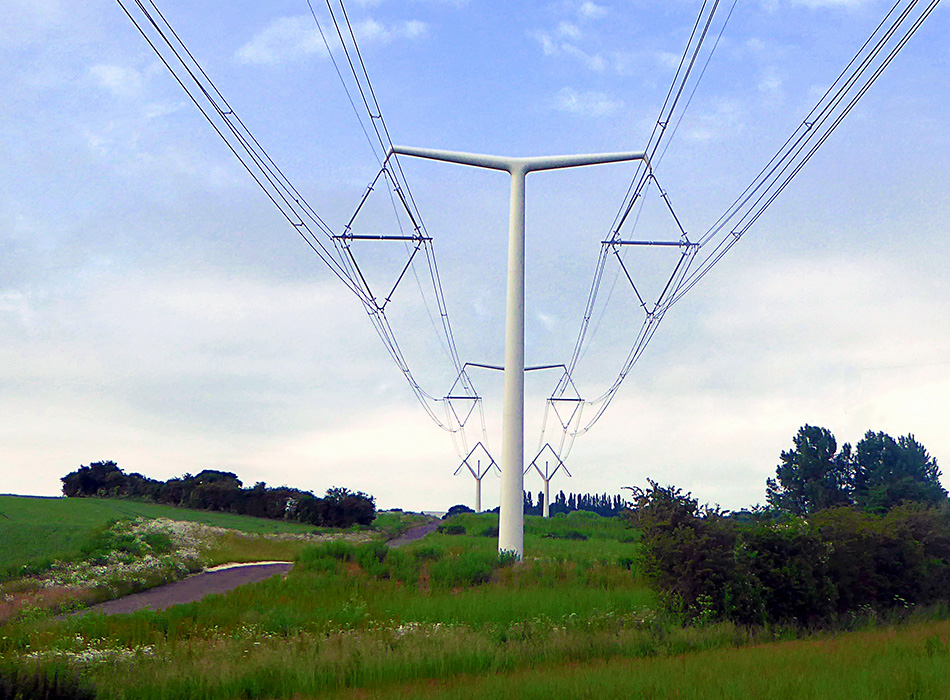Bystrup's innovative T-Pylon design was the winner of the Pylon Design competition.
Following a very high-quality field of 250 entries and 6 excellent finalists, which were featured at the London Design Festival, the judges were overwhelmed by the huge public interest in the competition.
The judging panel was made up of Chris Huhne, Nicholas Winser; Master of St Cross College Oxford and former Director of the V&A, Sir Mark Jones; architects Sir Nicholas Grimshaw and Bill Taylor; engineer Chris Wise; the journalist Jonathan Glancey, landscape architect Andrew Grant, Scottish Power's Jim Sutherland and Ruth Reed, former President of RIBA.
Bystrup worked closely with the National Grid to develop their T-pylon design further and the first new design of an electricity pylon in almost 90 years has been erected at a site in Nottinghamshire. The T-pylon is shorter, standing at about 120ft (36m); the old steel giants are typically 165ft (50m). It won't replace the 88,000 lattice pylons that currently bestride the UK countryside, but it will principally be used in the construction of new power lines in England and Wales.
Construction of the T-pylons began in September 2021, with all the conductors that transmit the energy between Bridgwater and Loxton in Somerset installed by March 2022. In March 2023 the National Grid successfully energised an initial section of the route meaning high voltage electricity is flowing through the 36 T-pylons, a new National Grid substation at Sandford, and the underground cables through the Mendip Hills.
As of April 2024, National Grid has confirmed that all 116 new T-pylons installed across the southwest, spanning 48.5km, connecting to the Hinkley Point C site power station are now fully wired up.
The conductors are energised and transporting electricity around the National Grid’s electricity network.
"This is an innovative design which is simple, classical and practical. Its ingenious structure also means that it will be much shorter and smaller than existing pylons and therefore less intrusive. This competition has been a great success in bringing forward new and creative approaches to a pylon model which has not changed since the 1920s. We are going to need a lot more pylons over the next few years to connect new energy to our homes and businesses and it is important that we do this in the most beautiful way possible."
Energy and Climate Change Secretary Chris Huhne
"RIBA, the department of Energy and Climate Change, and the National Grid launched the Pylon Design Competition in May 2011, seeking to find the next generation of electricity pylon for the UK. The competition was an astonishing success attracting media coverage from around the globe and 250 entries worldwide, with many prestigious architects and engineers submitting their designs.
The RIBA Competition Team, led by Joanne Wallis, provided superb support and expertise at all stages - from planning to launching, shortlisting and finally judging. They provided all the customer and admin support to the entrants, wrote the briefs and reports, organised the website and helped recruit the VIP judging panel. As the scope of the competition changed and grew, incorporating a physical exhibition of short-listed models at the V&A Museum in London, Joanne and the team adapted, providing vital input and assistance in planning the exhibition and supporting the media effort to ensure maximum publicity.
Professional knowledgeable, supportive, efficient and willing to go the extra mile - it was an absolute pleasure to work with the RIBA Competitions Team; I cannot recommend them highly enough"
Cass Martin, Pylon Design Team Project Manager, DECC
This past competition is just one of the many projects that RIBA Competitions deliver. We deliver choice, inspiration, and value to clients through expertly run architectural design competitions. Find out more information about holding or entering a competition.







